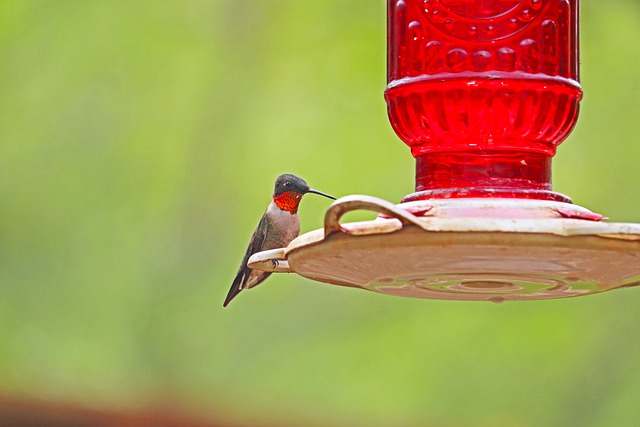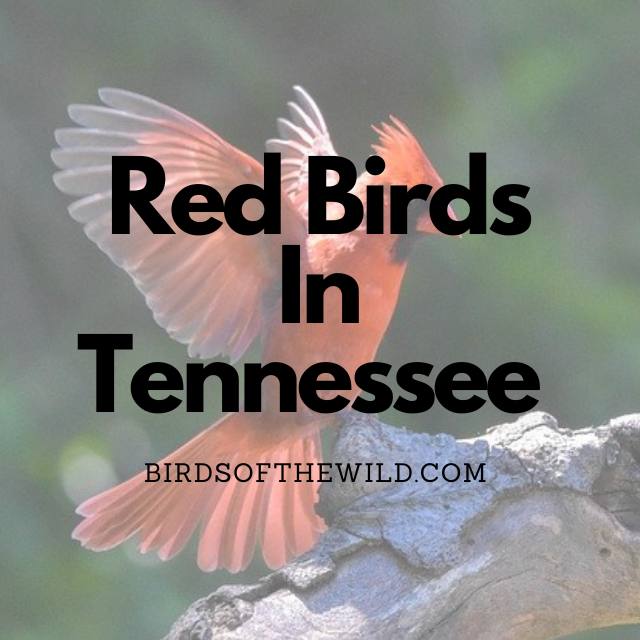In this article I’ll be going over 11 unique red birds that can be found in the state of Tennessee. Continue reading if you want to learn more about what these red birds are.
- Northern Cardinal
- Northern Flicker
- Ruby Throated Hummingbird
- Ruby Crowned Kinglet
- Summer Tanager
- House Finch
- Red Headed Woodpecker
- Red Bellied Woodpecker
- Rose Breasted Grosbeak
- Scarlet Tanager
- Red Winged Blackbird
11 Red Birds In Tennessee
1. Northern Cardinal (Cardinalis Cardinalis)

- Size: 21 – 23cm
- Weight: 42 – 48 grams
- Wingspan: 30 – 35cm
You’ll find northern cardinals in Tennessee all year round.
Northern cardinals are recognised by their mohawk-like head feathers, red exterior and beak with elements of black across the face. Females also have elements of red on their beaks and their body but, in smaller amounts, with the majority of their plumage a light brown color.
These cardinals can be found in woodlands, gardens, shrublands, wetlands and backyards if the sugar water or seeds in the feeders satisfy their taste buds.
As for the food they eat, it consists of small insects like beetles, true bugs, grasshoppers, caterpillars, ants, flies, spiders, centipedes, and snails. Seeds of weeds, berries among other smaller fruits are part of their diet too.
Northern cardinals are known to live for around 15 years in the wild although the actual number probably a lot less.
2. Northern Flicker (Colaptes Auratus)

- Size: 30 – 35cm
- Weight: 115 – 125 grams
- Wingspan: 50 – 55cm
These northern flickers can be found all across Tennessee year round.
Northern flickers are recognised by their mostly cream colored body with black spots, orange and black tail feathers and elements of red on the lower part of their face. Females look very similar to the males minus the red elements on their face.
You’ll often find northern flickers around woodlands, forest edges, and open fields with scattered trees, as well as city parks and suburbs.
As for what they tend to eat, it includes mostly insects along with smaller fruits and berries.
Northern flickers are known to live for around 5 – 7 years on average with the longest recorded to be 9 years and 2 months.
3. Ruby Throated Hummingbird (Archilochus Colubris)

- Size: 7 – 9cm
- Weight: 2 – 6 grams
- Wingspan: 8 – 11cm
Ruby throated hummingbirds can be found in Tennessee in late spring and summer when they breed.
A ruby throated hummingbird can be recognised by their plumage that is red, white and green. Their throat is the red part, its breast/stomach white in color and their wings and back an emerald green color. Females are mostly white and green in color.
As for what they eat, it ranges from small insects, fruits, sugar water from feeders, tree sap and of course the nectar produced by blooming flowers.
Ruby throated hummingbirds tend to stay near environments with flowerbeds as these birds have a very strong metabolism that requires them to feed multiple times per hour. Therefore, you can find them in fields, parks, backyards, and open clearings in forests.
As for how long these tiny little hummingbirds can live for, it’s known to be around 3 – 5 years on average with the longest recorded lifespan just short of 7 years.
4. Ruby Crowned Kinglet (Regulus Calendula)

- Size: 9 – 11cm
- Weight: 5 – 10 grams
- Wingspan: 16 – 18cm
Ruby crowned kinglets can be found all across Tennessee in their non-breeding fall and winter months.
These kinglets are recognised by their gray and green plumage throughout, besides the red/orange color on the top of their head. Females look almost the same bar the orange/red element on the head.
Ruby crowned kinglets will often be found by tall, dense conifer forests such as spruce, fir, and tamarack.
These kinglets eat the same food sources as most other birds in the wild, which in this case would be small insects, small berries, seeds and other smaller fruits.
As for how long a ring crowned kinglet can live for, it’s estimated to be around 4 – 6 years
5. Summer Tanager (Piranga Rubra)

- Size: 15 – 18cm
- Weight: 27 – 31 grams
- Wingspan: 28 – 30cm
Summer tanagers can be found all throughout Tennessee in their breeding season.
Male summer tanagers are recognised by their almost entirely red plumage with a grayish/silver beak. Females on the other hand are almost entirely yellow.
Summer tanagers are usually found within tropical forests of tall trees with an open canopy and mostly prefer to stay in lower elevations. They can reside within habitats that are 1800 meters above sea level too.
These tanagers mostly eat small insects like bees and wasps but, will also consume berries and smaller fruits foraged from backyards, parks among other environments rich with these food sources.
On average summer tanagers are known to live for around 5 years in the wild.
6. House Finch (Haemorhous Mexicanus)

- Size: 12.5 – 15cm
- Weight: 19 – 22 grams
- Wingspan: 20 – 25cm
House finches are year round residents all across Tennessee as it’s a permanent residence of theirs.
A House finch can be recognised by its red and brown plumage with their body mostly light brown and the head made up of a gradient red color with hints of brown. Females on the other hand are mostly brown with hints of black on their wings and back.
As for where you can find house finches, the number of habitats they stay within are quite vast ranging from dry desert, desert grassland, chaparral, oak savannah, streamsides, and open coniferous forests at elevations below 6,000 feet.
If the food is to their liking, like black sunflower seeds, these little birds will on occasion make their way to a feeder set out by a citizen. Other than seeds house finches also eat small insects like aphids as well as fruits and berries.
In the wild, house finches are known to live for around 10 years whilst captive finches can live upwards of 12 years.
7. Red Headed Woodpecker (Melanerpes Erythrocephalus)

- Size: 19 – 25cm
- Weight: 56 – 97 grams
- Wingspan: 40 – 45cm
You’ll find red headed woodpeckers within Tennessee on a permanent basis as they are year round residents.
Red headed woodpeckers are recognised by their red head and their black and white body and wings.
These woodpeckers tend to spend the majority of their time in groves, farm country, orchards, shade trees in towns, large scattered trees where you can find them in forest edges, orchards, open pine woods and the groves of taller trees.
A red headed woodpeckers diet consists of a wide variety of insects which includes spiders, earthworms, different types of nuts, seeds, berries along with other fruits. Sometimes these peckers may even eat small rodents or the contents of another birds eggs.
As for their lifespan, red headed woodpeckers have been known to live up to 10 years in the wild.
8. Red Bellied Woodpecker (Haemorhous Mexicanus)

- Size: 22.8 – 26.7cm
- Weight: 56 – 97 grams
- Wingspan: 38 – 46cm
Red bellied woodpeckers can be found all across Tennessee on a year round basis.
Most would recognise a red bellied woodpecker by the helmet like red streak on their head, their white chest feathers and striped zebra like pattern on their back and wings. Being a woodpecker also means their bills are relatively long and pointy. Females are very similar to males besides the lack of a red streak on their head
Red bellied woodpeckers tend to enjoy consuming suet, especially nut, insect, or fruit blends as well as fruits like oranges, grapes, apples, sunflower seeds and other smaller insects.
As for where they spend the majority of their time, it would be around woodlands and forests, from old oak trees to the lesser aged hardwoods and pines. They can also congregate around feeders within the backyard of Missouri citizens.
Red bellied woodpeckers are capable of living for around 12 years in the wild.
9. Rose Breasted Grosbeak (Pheucticus Ludovicianus)

- Size: 18 – 22cm
- Weight: 35 – 65 grams
- Wingspan: 29 – 33cm
Rose breasted grosbeaks can be found in eastern Tennessee when breeding whilst the remainder of the state is used as a migratory passage.
These grosbeaks are recognised by their black, white and red plumage where their back is black, their wings and wing tail feathers a mixture of black and white with their breast white, with a triangular red shape closer to the neck. Females on the other hand are mostly brown and white.
As for where you can find these grosbeaks, it will often be around deciduous forest, woodlands, parks and gardens.
Rose breasted grosbeaks are known to consume a variety of different food sources such as seeds like sunflower seeds or safflower, small insects as well as berries and other smaller fruits.
These rose breasted grosbeaks are known to live for around 7 years in the wild and significantly longer in captivity, extending to about 24 years there.
10. Scarlet Tanager (Piranga Olivacea)

- Size: 16 – 19cm
- Weight: 27 – 32 grams
- Wingspan: 25 – 30cm
You’ll find scarlet tanagers all throughout Tennessee in the spring and summer months when they breed.
Scarlet tanagers are recognised by their scarlet plumage, black wing and triangular silver/gray beak. Females are actually different in color to their male counterparts where their plumage is green with black wings.
These tanagers can be found within deciduous forest where oak maple, beech, and other trees are common. They also stay within mixed pine-oak woods, and occasionally in coniferous woods dominated by pine or hemlock.
As for what scarlet tanagers eat, it mostly consists of insects like caterpillars, moths, beetles, wasps, bees, aphids, berries and small fruits.
Scarlet tanagers can live up to 12 years in the wild although the actual lifespan for most scarlets will likely be far lower.
11. Red Winged Blackbird (Agelaius Phoeniceus)

- Size:17 – 24cm
- Weight: 70 – 85 grams
- Wingspan: 31 – 40cm
Red winged blackbirds can be found in all of Tennessee on a year round basis.
Red winged blackbirds are mostly black but, like the red bellied woodpecker above they do have elements of red on them, which in this case is specifically on their wings.
Females are smaller and look very different from the males and don’t have the defining red patch on their wing. Instead their plumage is mostly a spotty gray/black and white pattern.
These blackbirds can be found in and around freshwater marshes, in wooded or brushy swamps, rank weedy fields, hayfields and the upper edges of salt marshes.
Red winged blackbirds tend to forage for their food, where they may do so around open fields and mudflats. As for what foods they eat, it consist mostly of seeds but smaller insects like flies, snails, bigger prey like lizards, crayfish and fruits are part of their diet too.
They tend to live for around 2 – 3 years in the wild although captive ones have been known to live in the 20 year range.
Amhil Khan, a dedicated nature enthusiast and the founder of BirdsOfTheWild.com, is a passionate advocate for the captivating world of avian wonders. With a deep-seated curiosity about the intricate lives of birds, Amhil’s journey began as a fascination and has evolved into a mission to inspire others to appreciate and protect these magnificent creatures.
Amhil’s love for birds led to the creation of Birds of the Wild, a platform where his expertise in ornithology, coupled with his captivating storytelling, provides readers with an immersive and educational experience. Through his lens and words, he captures the essence of birds in their natural habitats, offering a glimpse into their behaviors, migrations, and the ecosystems they inhabit.

